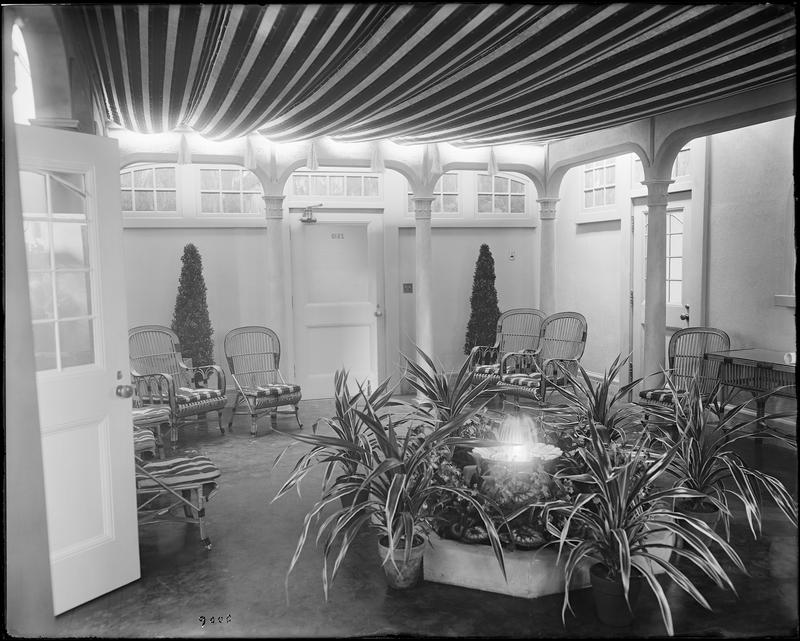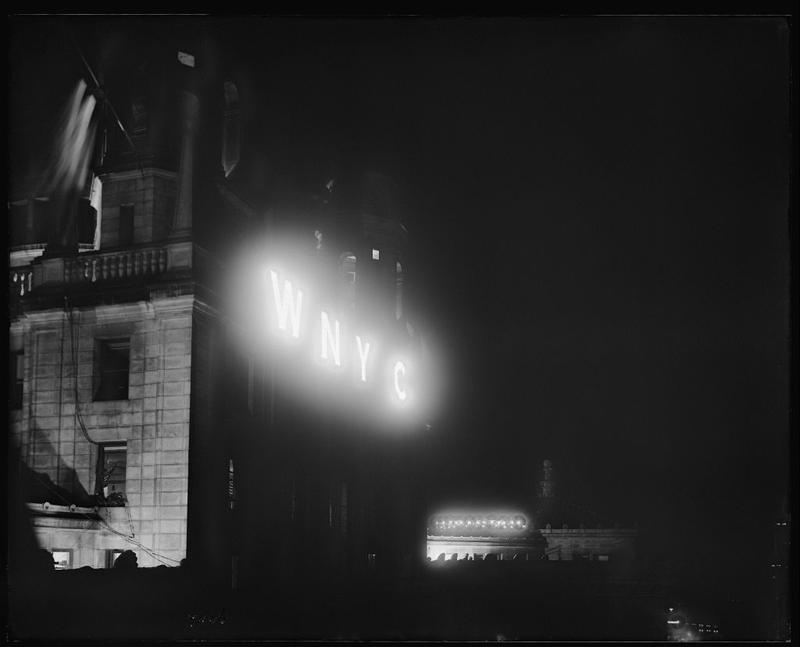 NYPR Archives & Preservation
NYPR Archives & Preservation
WNYC: 87 Years and the Romance of Radio

When WNYC began broadcasting 87 years ago, radio was still very much a toddler exploring the new terrain and occasionally falling down and getting bruised. There was also a certain mystique and mystery.
After all, there were disembodied voices coming from great distances through the heavens to a box in your living room, and without wires! It's no wonder that some people thought that the new medium might be a good way to communicate with the dead. Popular songs in the 1920s like I Wish There Was a Wireless to Heaven and Mr. Radio Man drew on that child-like belief.
Though there were no radio seances at WNYC's first home in the Municipal Building, there was a sense of the exotic that came into play with the new station's reception room as pictured here a day before our first broadcast. The decor, including rattan furniture, filtered lights, a bedouin-striped canopy, arches, columns, and a fountain were supplied courtesy of Wanamaker's Department Store. Visiting reporters were intrigued.
Radio Broadcast magazine
Away up in the tower, so far up that a man in the street below could not see the light, is WNYC. If a visitor be lucky and runs the gauntlet of elevator men, guards and other functionaries, he arrives at the studio in time for a pleasant illusion. Stepping through the door of WNYC's own home means going from the marble and glass of an office building into a tented palace that seems to have been created for romance. There is a colorful awning suspended below the ceiling and brilliant cane furniture to match, with a fountain in the center where spraying streams converge over the changing hues of an electric globe. [1]
The New York Evening Post
The reception room of Moorish design is suggestive of a turret in a Moorish castle. This room is furnished in black, red and yellow. In a circle around the walls are artificial stone pillars about twelve feet high, from which is hung a canopy, colored with broad stripes of yellow, red, mauve and black. In the center of the room is a small fountain, illuminated by vari-colored electric lights which plays on ferns and red and yellow flowers. At intervals about the room are boxed ever green trees and plants. To the left is the broadcasting room proper and to the right is the office, also done in rich Moorish combinations. It is fitted with wicker chairs, painted brown and blue, with a heavy lustrous rug on the floor. Beyond the office are the studios, walls of which are done in salmon color. The floor is covered with linoleum designed to suggest red and brown tile. These rooms are also decorated with wicker chairs, painted green, and with green lamps and rugs.[2]
The Brooklyn Daily Eagle
In the studio, which is located on the 25th floor of the Municipal Building, no detail has been overlooked to make it not only artistically attractive, but also efficient from the standpoint of the work which it will be called on to perform. ... The reception room is patterned after a Spanish garden with columns, arches, stone benches and a striped canopy effect from the ceiling. A fountain has been erected upon which play colored lights. A niche forms a pleasing part of the decorative sceme...[3]
The New York Times
The corridors of the twenty-fifth-floor [of the Municipal Building] were converted into a fairyland with long festoons of electric lights, which led the guests through a Spanish pergola into the reception room. Under a colored awning this lounge opened upon a large illuminated fountain, while songbirds in cages occupied convenient niches.[4]
The New York Telegram and Evening Mail
While bands played and trumpets flared, your humble reporter 'breezed' in and out among the Tuxedoed officials and lovely crepe de chined ladies, noting as best he could the countless attractive features of the station. So, with memory as guide, let's stroll together through the four large rooms and the smaller anteroom, on the top floor of the Municipal Building, which have been given over to the radio plant.
Coming off the elevator we proceed down a long laurel-trimmed hallway, (it looked like laurel anyway) made more cheery by yellow and blue electric lights. The first door we come to leads into the transmitting and control room, where is located the 1,000 watt set, the monitoring set for listening-in on the station's own program and for picking up distress calls, as is required by government regulation.
In attendance here, we find Raymond Asserson, chief radio engineer, and his assistants Joseph A. Bryan and George E. Whitcom, Jr., who are rated as operators. From this room, we pass into the reception room, with windows facing westward, affording a view of the Palisades and a cool breeze from the Hudson. Decoratively, this is perhaps, the most attractive room of the suite furnished with cream-colored rattan chairs, lounges and taboret, all placed appropriately around an illuminated fountain in the center of the floor. Chintz curtains lend a dash of color to the rough, cream tinted walls.
Next is the outer studio. This, too, is a resplendid interior decoratese handiwork, finished in blue and white. At the extreme northeast corner is the main studio, the largest we have seen, with three microphones placed at proper vantage points and mounted on rattan supports to harmonize with the surroundings.
One note predominates throughout--comfort. Chairs are large and cushions deep. There is ample room to move about and there is none of the air of austerity so noticeable in certain studios...
The entire northeast corner of the roof was illuminated with varied-colored lights, and the rough corners, cornices and skylights hidden with branches to produce and arboreal effect. Immediately over the heads of the crowd hung the 125 foot, eight strand cage antenna suspended at its high end from the very top most peak of the building's loftiest tower. As a concluding touch, the letters W N Y C nearly eight feet high, beamed out against the darkened sky from the front of the building and red fire glowed softly from two of the cupolas."[5]
For more on WNYC's opening night please see: When WNYC Became Real. Also: Mayor Hylan's Opening Night Remarks.
_______________________________________
[1] James C. Young, writing in "Radio-Voice of the City," Radio Broadcast, Vol. 6, No.3, January, 1925, pg. 444.
[2] "City Radio Station Will Open Tonight," The New York Evening Post, July 8, 1924, pg.6.
[3] "Municipal Radio Station Will Be Given First Test Wednesday at Midnight," The Brooklyn Daily Eagle, June 15, 1924.
[4] "City's Radio Plant Opened by Mayor," The New York Times, July 9, 1924, pg. 7.
[5] Rogers, Stuart, "City Station is Broadcasting Trial Horse: Behind the Scenes at WNYC--Defender of Free Air," The New York Telegram and Evening Mail, July 12, 1924, pg. 5.
________________________________________________________________________________________
Broadcast on WNYC Today in:
1924: At 8:56 p.m., announcer Thomas (Tommy) H. Cowan signs WNYC-AM on the air for the first time. This is followed by Marian Fein singing the Star-Spangled Banner, accompanied by the Police Department Band. The inaugural ceremonies include representatives of the Catholic, Protestant, and Jewish faiths, each giving their blessings to this broadcast endeavor. Performing are Vincent Lopez and his orchestra; the Police Quartette, the Six Brown Brothers (a saxophone sextet); and singer Estelle Carey. In attendance: Mayor John F. Hylan, and other civic leaders, including the Queens and Staten Island Borough Presidents, businessman Rodman Wanamaker and former Commissioner Grover Whalen, the person largely responsible for putting WNYC on the air.
In his broadcast remarks, Mayor Hylan speaks of the effect of copyright on the broadcasting of music and mercenary use of radio with commercial advertising. His Honor also suggests the possibility of listeners being taxed to pay for programming. Hylan adds: "To ensure uninterrupted programs of recreational entertainment for all the people is one of the compelling reasons for the installation of the Municipal Radio Broadcasting Station. ... The improvement of the people in every walk of life, through the educative power of radio, may also be considered one of its paramount purposes. ... Programs sufficiently diversified to meet all tastes with musical concerts, both vocal and instrumental, featured at all times, should make 'tuning-in' on the Municipal Radio pleasant as well as profitable..."
